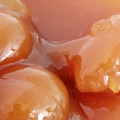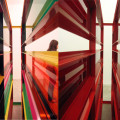In the course of his 30 years of practice, interdisciplinary artist Guy Laramée has created in such varied and numerous disciplines as theater writing and directing, contemporary music composition, musical instrument design and building, singing, video, scenography, sculpture, installation, painting, and literature. He has received more than 30 arts grants and was awarded the Canada Council’s Joseph S. Stauffer award for musical composition. His work has been presented in United States, Belgium, France, Germany, Switzerland, Japan, and Latin America. The erosion of cultures – and of “culture” as a whole – is the theme that runs through the last 25 years of my artistic practice. Cultures emerge, become obsolete, and are replaced by new ones. With the vanishing of cultures, some people are displaced and destroyed. We are currently told that the paper book is bound to die. The library, as a place, is finished. One might ask so what? Do we really believe that “new technologies” will change anything concerning our existential dilemma, our human condition? And even if we could change the content of all the books on earth, would this change anything in relation to the domination of analytical knowledge over intuitive knowledge? What is it in ourselves that insists on grabbing, on casting the flow of experience into concepts?
When I was younger, I was very upset with the ideologies of progress. I wanted to destroy them by showing that we are still primitives. I had the profound intuition that as a species, we had not evolved that much. Now I see that our belief in progress stems from our fascination with the content of consciousness. Despite appearances, our current obsession for changing the forms in which we access culture is but a manifestation of this fascination.
My work, in 3D as well as in painting, originates from the very idea that ultimate knowledge could very well be an erosion instead of an accumulation. The title of one of my pieces is “ All Ideas Look Alike”. Contemporary art seems to have forgotten that there is an exterior to the intellect. I want to examine thinking, not only “what” we think, but “that” we think.
So I carve landscapes out of books and I paint romantic landscapes. Mountains of disused knowledge return to what they really are: mountains. They erode a bit more and they become hills. Then they flatten and become fields where apparently nothing is happening. Piles of obsolete encyclopedias return to that which does not need to say anything, that which simply IS. Fogs and clouds erase everything we know, everything we think we are.
After 30 years of practice, the only thing I still wish my art to do is this: to project us into this thick “cloud of unknowing.”
Guy Laramée: Erosion of Cultures
LINK: www.guylaramee.com
VIDEOCOMMENTSRELATED POST |
|
|
|
|








































